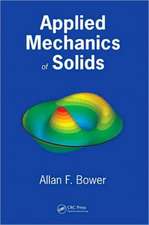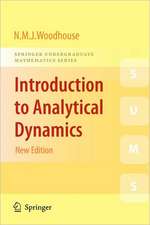Mathematical Models in Natural Science and Engineering: Foundations of Engineering Mechanics
Autor Juri I. Neimark Traducere de Victor Gloumov, Mark M. Koganen Limba Engleză Hardback – 11 feb 2003
| Toate formatele și edițiile | Preț | Express |
|---|---|---|
| Paperback (1) | 1230.53 lei 43-57 zile | |
| Springer Berlin, Heidelberg – 20 iul 2012 | 1230.53 lei 43-57 zile | |
| Hardback (1) | 1235.43 lei 43-57 zile | |
| Springer Berlin, Heidelberg – 11 feb 2003 | 1235.43 lei 43-57 zile |
Din seria Foundations of Engineering Mechanics
- 15%
 Preț: 585.26 lei
Preț: 585.26 lei - 18%
 Preț: 1112.30 lei
Preț: 1112.30 lei - 18%
 Preț: 786.36 lei
Preț: 786.36 lei - 15%
 Preț: 650.55 lei
Preț: 650.55 lei - 15%
 Preț: 646.11 lei
Preț: 646.11 lei - 18%
 Preț: 948.47 lei
Preț: 948.47 lei - 18%
 Preț: 956.69 lei
Preț: 956.69 lei - 15%
 Preț: 643.34 lei
Preț: 643.34 lei - 18%
 Preț: 948.47 lei
Preț: 948.47 lei - 18%
 Preț: 953.82 lei
Preț: 953.82 lei - 18%
 Preț: 951.29 lei
Preț: 951.29 lei - 18%
 Preț: 1386.62 lei
Preț: 1386.62 lei - 15%
 Preț: 644.49 lei
Preț: 644.49 lei - 18%
 Preț: 2117.76 lei
Preț: 2117.76 lei - 18%
 Preț: 951.91 lei
Preț: 951.91 lei - 18%
 Preț: 957.62 lei
Preț: 957.62 lei -
 Preț: 391.99 lei
Preț: 391.99 lei - 18%
 Preț: 1223.43 lei
Preț: 1223.43 lei - 18%
 Preț: 1213.46 lei
Preț: 1213.46 lei - 15%
 Preț: 634.32 lei
Preț: 634.32 lei - 15%
 Preț: 644.30 lei
Preț: 644.30 lei - 18%
 Preț: 952.26 lei
Preț: 952.26 lei - 15%
 Preț: 646.11 lei
Preț: 646.11 lei - 15%
 Preț: 641.71 lei
Preț: 641.71 lei - 15%
 Preț: 635.01 lei
Preț: 635.01 lei - 18%
 Preț: 955.25 lei
Preț: 955.25 lei - 18%
 Preț: 1234.46 lei
Preț: 1234.46 lei - 20%
 Preț: 1289.59 lei
Preț: 1289.59 lei - 18%
 Preț: 952.89 lei
Preț: 952.89 lei - 18%
 Preț: 1247.88 lei
Preț: 1247.88 lei - 18%
 Preț: 947.18 lei
Preț: 947.18 lei - 15%
 Preț: 631.21 lei
Preț: 631.21 lei - 18%
 Preț: 1231.16 lei
Preț: 1231.16 lei
Preț: 1235.43 lei
Preț vechi: 1506.62 lei
-18% Nou
Puncte Express: 1853
Preț estimativ în valută:
236.47€ • 256.95$ • 198.77£
236.47€ • 256.95$ • 198.77£
Carte tipărită la comandă
Livrare economică 21 aprilie-05 mai
Preluare comenzi: 021 569.72.76
Specificații
ISBN-13: 9783540436805
ISBN-10: 3540436804
Pagini: 588
Ilustrații: XII, 572 p.
Dimensiuni: 156 x 234 x 40 mm
Greutate: 0.95 kg
Ediția:2003
Editura: Springer Berlin, Heidelberg
Colecția Springer
Seria Foundations of Engineering Mechanics
Locul publicării:Berlin, Heidelberg, Germany
ISBN-10: 3540436804
Pagini: 588
Ilustrații: XII, 572 p.
Dimensiuni: 156 x 234 x 40 mm
Greutate: 0.95 kg
Ediția:2003
Editura: Springer Berlin, Heidelberg
Colecția Springer
Seria Foundations of Engineering Mechanics
Locul publicării:Berlin, Heidelberg, Germany
Public țintă
ResearchCuprins
1 Dynamical system.- 2 Fluid outflow from a vessel.- 3 Equilibrium and auto-oscillations of fluid level in the vessel with simultaneous inflow and outflow.- 4 Transitive processes, equilibrium states and auto-oscillations.- 5 Dynamics of the water surface level in a reservoired hydropower station.- 6 Energetic model of the heart.- 7 Soiling a water reservoir with a bay and the Caspian Sea puzzles.- 8 Exponential processes.- 9 Dynamics in coexistence of populations.- 10 Flow biological reactor.- 11 Mathematical model for the immune response of a living organism to an infectious invasion.- 12 Mathematical model for the community “Producers —Products — Managers”.- 13 Linear oscillators.- 14 Electromechanical analogies. Lagrange-Maxwell equations.- 15 Galileo-Huygens clock.- 16 Generator of electric oscillations.- 17 Soft and hard regimes of exciting auto-oscillations.- 18 Stochastic oscillator (the “contrary clock”).- 19 Instability and auto-oscillations caused by friction.- 20 Forced oscillations of a linear oscillator.- 21 Parametric excitation and stabilization.- 22 Normal oscillations and beatings.- 23 Stabilizing an inverted pendulum.- 24 Controllable pendulum and a two-legged pacing.- 25 Dynamical models for games, teaching and rational behaviour.- 26 Perception and pattern recognition.- 27 Kepler laws and the two-body problem solved by Newton.- 28 Distributed dynamical models in mechanics and physics.- 29 Fundamental solution of the thermal conductivity equation.- 30 Running waves and the dispersion equation.- 31 Faraday-Maxwell theory of electromagnetism and the Maxwell-Hertz electromagnetic waves.- 32 Wave reflection and refraction.- 33 Standing waves and oscillations of a bounded string.- 34 Microparticles.- 34.1 Mathematical formalism in quantummechanics.- 34.2 Free microparticle.- 34.3 Microparticle in a potential well.- 34.4 Diffusion of a microparticle through a potential barrier.- 34.5 Atom of hydrogen.- 34.6 Quantum linear oscillator.- 34.7 Newton quantum equation.- 35 Space and time.- 36 Speeding up relativistic microparticles in a cyclotron.- 37 Mathematics as a language and as an operating system and models.- 38 Geometrical, physical, analogous, mathematical and imitative types of modelling.- 38.1 Physical modelling.- 38.2 Imitative modelling.- 39 General scheme of mathematical modelling.- 40 Models of vibratory pile driving.- 41 The fundamental mathematical model of the modern science and the theory of oscillations.- 41.1 A dynamical system as a basic mathematical model of the contemporary science.- 41.2 A.A. Andronov and the theory of oscillations.- 42 Mathematical model as a fruitful idea of research. The D-partition.- 43 Idealization, mathematical correctness and reality.- 43.1 Frictional regulator of rotating velocity.- 43.2 Panleve paradox and auto-oscillations under Coulomb friction.- 44 Dynamical interpretation of the least-square method and global search optimization with use of an adaptive model.- 44.1 A universal recurrent form of the LSQ method.- 44.2 Searching global optimization with an adaptive model.- 45 Theoretical game model of the human society.- 45.1 Game-like perception of life and a theoretical game model of the society.- 45.2 Organizational and management principles of the society.- 45.3 An ideal public game.- 45.4 A problem of involving managers and authorities into a general playing interaction.- 45.5 Conclusion.
Textul de pe ultima copertă
This book helps the reader become familiar with various mathematical models for mechanical, electrical, physical, atronomical, chemical, biological, ecological, cybernetical and other systems and processes. The models examined are evolutionary models, i.e. the models of time-varying processes known as dynamic systems, such as fluid flow, biological processes, oscillations in mechanical and electromagnetic systems, and social systems. The book shows readers how to identify appropriate situations for modelling, how to address difficulties in creating models, and how to learn what mathematics teaches us about the modelling of dynamical phenomena in our surrounding world.It is interesting for a wide spectrum of readers, students of natural science and engineering, and also for researchers in these fields.
Caracteristici
Introduces to the art of mathematical modelling Illustrates the most relevant types of models by a collection of more than elaborated 30 examples Includes supplementary material: sn.pub/extras










